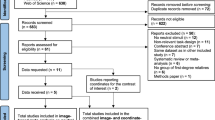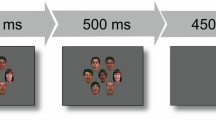Abstract
When primates passively observe other subjects perform specific gestures or actions, premotor and motor cortical areas involved in the internal representation and actual execution of those actions exhibit neuronal activation. This mirror mechanism matches observation, representation, and execution, facilitating internal motor rehearsal, imitation, recognition of actions by others and their meanings, and social learning. Schizophrenic patients have deficits in processing affect displayed by other people's faces, which likely relates to the poor social adaptation and functioning seen in the condition. We hypothesized that, when correctly performing working-memory tasks requiring facial affect processing, schizophrenic patients would show relative increased activity in brain areas involved in social learning and in the internal representation of facial expressions when compared to controls. We used functional magnetic resonance imaging in schizophrenic patients and normal controls to detect relative changes of blood flow in cortical areas related to the representation of facial expressions while the subjects performed simple working-memory tasks with facial emotion diagrams or color circles as cues. We found that, when the task cues were facial expressions in contrast to color circles, the schizophrenic group exhibited increased activation of the face movement areas in motor and pre-motor cortex.
Similar content being viewed by others
Log in or create a free account to read this content
Gain free access to this article, as well as selected content from this journal and more on nature.com
or
References
Addington J, Addington D . (1998): Facial affect recognition and information processing in schizophrenia and bipolar disorder. Schizophr Res 32: 171–181
Allison T, Puce A, McCarthy G . (2000): Social perception from visual cues: role of the STS region. Trends Cogn Sci 4: 267–278
Andreasen N, Narsallah HA, Dunn V, Olson SC, Grove WM, Ehrhardt JC, Coffman JA, Crossett JHW . (1986): Structural abnormalities in the frontal system in schizophrenia. Arch Gen Psychiatry 43: 136–144
Borod JC, Martin CC, Alpert M, Brozgold A, Welkowitz J . (1993): Perception of facial emotion in schizophrenic and right brain-damaged patients. J Nerv Ment Dis 181: 494–502
Braff DL, Swerdlow NR, Geyer MA . (1995): Gating and habituation deficits in the schizophrenia disorders. Clin Neurosci 3: 131–139
Callicott JH, Ramsey NF, Tallent K, Bertolino A, Knable MB, Coppola R, Goldberg T, Van Gelderen P, Mattay VS, Frank JA, Moonen CT, Weinberger DR . (1998): Functional magnetic resonance imaging brain mapping in psychiatry: methodological issues illustrated in a study of working memory in schizophrenia. Neuropsychopharmacology 18: 186–196
Decety J, Grezes J, Costes N, Perani D, Jeannerod M, Procyk E, Grassi F, Fazio F . (1997): Brain activity during observation of actions. Influence of action content and subject's strategy. Brain 120: 1763–1777
Decety J, Perani D, Jeannerod M, Bettinardi V, Tadary B, Woods R, Mazziotta JC, Fazio F . (1994): Mapping motor representations with positron emission tomography. Nature 371 (6498)): 600–602
Dickerson F, Boronow JJ, Ringel N, Parente F . (1996): Neurocognitive deficits and social functioning in outpatients with schizophrenia. Schizophr Res 21: 75–83
Dougherty F, Bartlett E, Izard C . (1974): Response of schizophrenics to expressions of the fundamental emotions. J Clin Psychol 30: 243–246
Fadiga L, Fogassi L, Gallese V, Rizzolatti G . (2000): Visuomotor neurons: ambiguity of the discharge or ’motor’ perception? Int J Psychophysiol 35: 165–177
Federman EJ, Drebing CE, Zaref JI, Oepen G . (1998): Processing and recognition of facial affect in schizophrenia. Percept Mot Skills 87: 484–486
Friston KJ, Jezzard P, Turner R . (1994): Analysis of functional MRI time series. Human Brain Mapp 1: 153–171
Friston KJ, Williams S, Howard R, Frackowiak RSJ, Turner R . (1996): Movement related effects in fMRI time-series. Mag Res Med 35: 346–355
Friston KJ, Holmes AP, Price CJ, Buchel C, Worsley KJ . (1999): Multisubject fMRI studies and conjunction analyses. Neuroimage 9: 385–396
Fuster JM . (1989): The Prefrontal Cortex: Anatomy, Physiology, and Neuropsychology of the Frontal Lobe, 2nd ed. New York, Raven Press
Gallese V, Fadiga L, Fogassi L, Rizzolatti G . (1996): Action recognition in the premotor cortex. Brain 119: 593–609
Gallese V, Goldman A . (1998): Mirror neurons and the simulation theory of mind-reading. Trends Cogn Sci. 2: 493–501
Grafton ST, Woods RP, Mazziotta JC, Phelps ME . (1991): Somatotopic mapping of the primary motor cortex in humans: activation studies with cerebral blood flow and positron emission tomography. J Neurophysiol 66: 735–743
Grafton ST, Woods RP, Mazziotta JC . (1993): Within-arm somatotopy in human motor areas determined by positron emission tomography imaging of cerebral blood flow. Exp Brain Res 95: 172–176
Green MF . (1996): What are the functional consequences of neurocognitive deficits in schizophrenia? Am J Psychiatry 153: 321–330
Habel U, Gur RC, Mandal MK, Salloum JB, Gur RE, Schneider F . (2000): Emotional processing in schizophrenia across cultures: standardized measures of discrimination and experience. Schizophr Res 42: 57–66
Hajnal JV, Myers R, Oatridge A, Schwieso JE, Young IR, Bydder GM . (1994): Artifacts due to stimulus correlated motion in functional imaging of the brain. Mag Res Imaging 31: 283–291
Halgren E, Raij T, Marinkovic K, Jousmaki V, Hari R . (2000): Cognitive response profile of the human fusiform face area as determined by MEG. Cereb Cortex 10: 69–81
Hari R, Forss N, Avikainen S, Kirveskari E, Salenius S, Rizzolatti G . (1998): Activation of human primary motor cortex during action observation: a neuromagnetic study. Proc Natl Acad Sci 95: 15061–15065
Hariri A, Quintana J, Kovalik E, Bookheimer S . (1999): Processing of facial affect in schizophrenics: an fMRI study. Neuroimage 9: 647
Hauser MD . (1999): Perseveration, inhibition and the prefrontal cortex: a new look. Curr Opin Neurobiol 9: 214–222
Haxby JV, Hoffman EA, Gobbini MI . (2000): The distributed human neural system for face perception. Trends Cogn Sci 4: 223–233
Heckers S, Goff D, Schacter DL, Savage CR, Fischman AJ, Alpert NM, Rauch S . (1999): Functional imaging of memory retrieval in deficit vs nondeficit schizophrenia. Arch Gen Psychiatr 56: 1117–1123
Heeger DJ, Huk AC, Geisler WS, Albrecht DG . (2000): Spikes versus BOLD: what does neuroimaging tell us about neuronal activity? Nature Neurosci 3: 631–633
Heimberg C, Gur RE, Erwin RJ, Shtasel DL, Gur RC . (1992): Facial emotion discrimination: III. Behavioral findings in schizophrenia. Psychiatry Res 42: 253–265
Hellewell JSE, Whittaker JF . (1998): Affect perception and social knowledge in schizophrenia. In Mueser KT, Tarrier N (eds.), Handbook of social functioning in schizophrenia. Boston, Allyn & Bacon, pp 197–212
Iacoboni M, Woods RP, Brass M, Bekkering H, Mazziotta JC, Rizzolatti G . (1999): Cortical mechanisms of human imitation. Science 286: 2526–2528
Ingvar DH, Franzen G . (1974): Abnormalities of cerebral blood flow distribution in patients with chronic schizophrenia. Acta Psychiatr Scand 50: 425–462
Iscoe I, Veldman DJ . (1963): Perception of an emotional continuum by schizophrenics, normal adults and children. J Clin Psychol 19: 272–276
Izard C . (1959): Paranoid schizophrenic and normal subjects’ perception of photographs of human faces. J Consult Psychol 23: 119–124
Jeannerod M, Frak V . (1999): Mental imaging of motor activity in humans. Curr Opin Neurobiol 9: 735–739
Jeste DV, Galasko D, Corey-Bloom J, Walens S, Granholm E . (1996): Neuropsychiatric Aspects of the Schizophrenias. In Fogel BS, Schiffer RB, Rao SM (eds), Neuropsychiatry. Baltimore, Williams & Wilkins, pp 325–344
Knight RT, Staines WR, Swick D, Chao LL . (1999): Prefrontal cortex regulates inhibition and excitation in distributed neural networks. Acta Psychol 101: 159–178
Konishi S, Nakajima K, Uchida I, Kikyo H, Kameyama M, Miyashita Y . (1999): Common Inhibitory mechanism in human inferior prefrontal cortex revealed by event-related functional MRI. Brain 122: 981–991
L'Hermitte F, Deroulsne J, Signoret JL . (1972): [Neuropsychological analysis of the frontal syndrome]. Rev Neurol 127: 415–440
Lotze M, Erb M, Flor H, Huelsmann E, Godde B, Grodd W . (2000): fMRI evaluation of somatotopic representation in human primary motor cortex. Neuroimage 11: 473–481
Muzekari LH, Bates ME . (1977): Judgment of emotion among chronic schizophrenics. J Clin Psychol 33: 662–666
Nakamura K, Kawashima R, Ito K, Sugiura M, Kato T, Nakamura A, Hatano K, Nagumo S, Kubota K, Fukuda H, Kojima S . (1999): Activation of the right inferior frontal cortex during assessment of facial emotion. J Neurophysiol 82: 1610–1614
Nishitani N, Hari R . (2000): Temporal dynamics of cortical representation for action. Proc Natl Acad Sci 97: 913–918
Nuechterlein KH, Dawson ME . (1984): Information processing and attentional functioning in the development course of schizophrenic disorders. Schizophrenia Bull 10: 160–203
Pillowski I, Bassett D . (1980): Schizophrenia and the response to facial emotions. Compr Psychiatry 21: 236–244
Quintana J, Fuster JM . (1992): Mnemonic and predictive functions of cortical neurons in a memory task. Neuroreport 3: 721–724
Quintana J, Fuster JM . (1993): Spatial and temporal factors in the role of prefrontal and parietal cortex in visuo-motor integration. Cerebral Cortex 3: 122–132
Quintana J, Fuster JM . (1999): From perception to action: temporal integrative functions of prefrontal and parietal neurons. Cerebral Cortex 9: 213–221
Quintana J, Kovalik E . (1999): Differences in prefrontal and parietal association cortex activation between controls and schizophrenic patients during decision-making working memory tasks. Soc Neurosci Abs 25: 19
Rees G, Friston K, Koch C . (2000): A direct quantitative relationship between the functional properties of human and macaque V5. Nature Neurosci 3: 716–723
Rizzolatti G, Arbib MA . (1998): Language within our grasp. Trends Neurosci 21: 188–194
Rizzolatti G, Fadiga L, Fogassi L, Gallese V . (1999): Resonance behaviors and mirror neurons. Arch Ital Biol 137: 85–100
Roth M, Decety J, Raybaudi M, Massarelli R, Delon-Martin C, Segebarth C, Morand S, Gemignani A, Decorps M, Jeannerod M . (1996): Possible involvement of primary motor cortex in mentally simulated movement: a functional magnetic resonance imaging study. Neuroreport 7: 1280–1284
Schnitzler A, Salenius S, Salmelin R, Jousmaki V, Hari R . (1997): Involvement of primary motor cortex in motor imagery: a neuromagnetic study. Neuroimage 6: 201–208
Streit M, Wolwer W, Gaebel W . (1997): Facial-affect recognition and visual scanning behaviour in the course of schizophrenia. Schizophr Res 24: 311–317
Walker E, Marwit SJ, Emory E . (1980): A cross-sectional study of emotion recognition in schizophrenics. J Abnorm Psychol 89: 428–436
Weinberger DR, Berman KF, Zec RF . (1986): Physiologic dysfunction of dorsolateral prefrontal cortex in schizophrenia. Arch Gen Psychiatry 43: 114–124
Weinberger DR, Wagner RL, Wyatt RJ . (1983): Neuropathological studies of schizophrenia: a selective review. Schizophr Bull 9: 193–212
Woods RP, Grafton ST, Holmes CJ, Cherry SR, Mazziotta JC . (1998): Automated image registration: 1. General methods and intrasubject, intramodality validation. J Comp Assist Tomography 22: 139–152
Acknowledgements
We thank Dr. A. Kopelowicz (San Fernando Mental Health Center, Los Angeles Department of Mental Health) and Drs. W. Wirshing, D. Ames-Wirshing, and Scott Saunders (Schizophrenic Research Clinic, West Los Angeles VA Health Care Center) for generously agreeing to the recruitment of subjects from their respective clinics. We also thank Dr. Marco Iacoboni for his generosity and his time in reviewing the manuscript; his suggestions are greatly appreciated. Supported by a Department of Veteran Affairs (Office of Research and Development, Medical Research Service) Advanced Research Scientist Career Development Award, and by a NARSAD Staglin Young Investigator Award to J.Q., as well as by contributions from the VA's VISN-22 MIRECC, the Brain Mapping Medical Research Organization, the Brain Mapping Support Foundation, the Pierson-Lovelace Foundation, the Ahmanson Foundation, the Tamkim Foundation, the Jennifer-Jones Simon Foundation, the Capital Group Companies Charitable Foundation, the Robson Family, the Northstar Fund, and a National Center for Research Resources grant RR12169.
Author information
Authors and Affiliations
Corresponding author
Rights and permissions
About this article
Cite this article
Quintana, J., Davidson, T., Kovalik, E. et al. A Compensatory Mirror Cortical Mechanism for Facial Affect Processing in Schizophrenia. Neuropsychopharmacol 25, 915–924 (2001). https://doi.org/10.1016/S0893-133X(01)00304-9
Received:
Revised:
Accepted:
Published:
Issue date:
DOI: https://doi.org/10.1016/S0893-133X(01)00304-9



